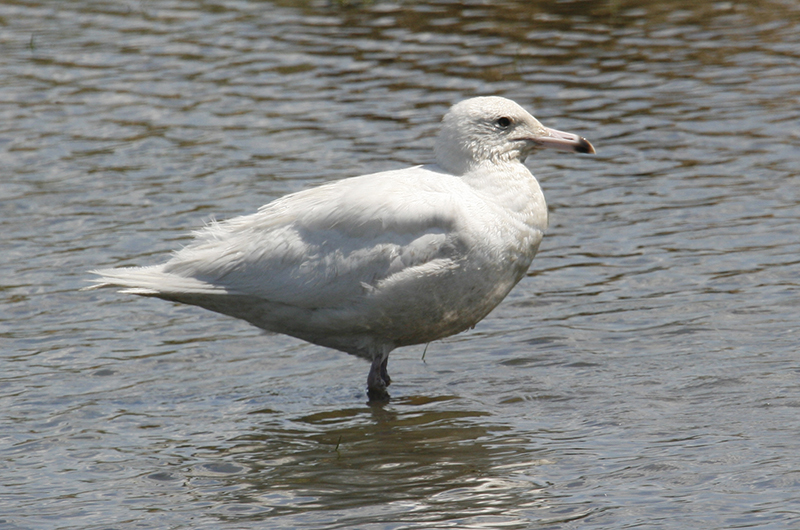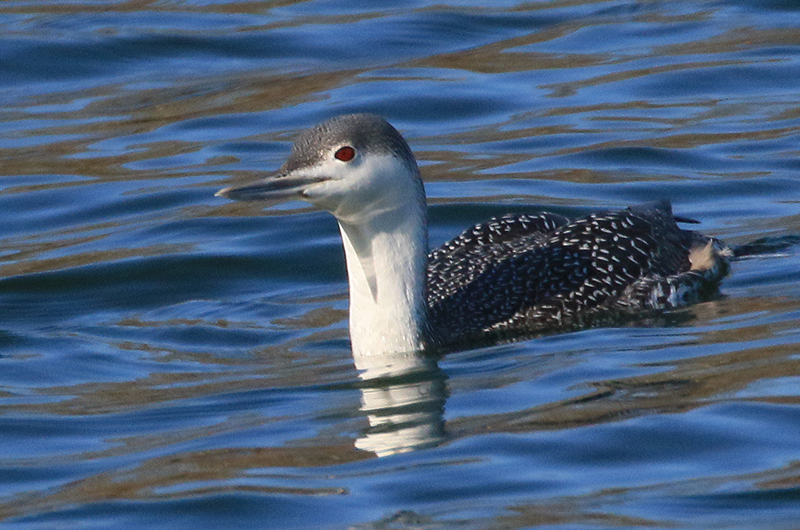Gulls are not easy to identify because small plumage differences can mean a different species. Two species are especially difficult: glaucous and Iceland, the so-called “white-winged” gulls.
Identifying these white-winged gulls to species came up this week when Kath MayWaite found a flock of gulls in a yard near the Head of the Lagoon on March 4. The presence of gulls in the yard was unusual in itself, but one bird was very different from the herring gulls because it was all white. She photographed the bird.
Opinions about its identification are mixed. The bird was slightly smaller than the herring gulls, suggesting an Iceland gull. But it also looks like it had the heavier bill of a glaucous gull. The gulls are similar enough that apparent size trumps bill size, so Iceland gull it is.
Another pair of closely related birds that are difficult to identify are the fairly common red-throated loon and the uncommon/rare Pacific loon. These two species are difficult enough to identify in their non-breeding plumage, but it gets even harder when they are starting to molt into their breeding plumage. The bird was first seen by Matt Pelikan on March 8 at the Head of the Lagoon, while Allan Keith spotted it there the next day. They discussed their thoughts on March 10 and decided that photographs were needed. I found the bird that afternoon in the heavy drizzle. I used a point and shoot camera and the photos were barely clear enough to determine that the bird was indeed a red-throated loon. Lanny McDowell got good close-up photos of the loon on March 11.
Bird Sightings
John Nelson and I teamed up to bird the Chappaquiddick beaches on March 10. We were both surprised at the overall scarcity of ducks. We counted 175 bufflehead, 125 black ducks, 50 common goldeneye, 25 red-breasted mergansers, eight greater scaup, five mallard, 10 common eiders, and 10 each of the three scoter species. We both felt those numbers were very low.
Mr. Nelson was not surprised, though, as he feels that the ocean and pond communities are depauperate. “Would you eat at a restaurant that does not serve food?”
There were highlights, though, including a peregrine falcon that has been hanging out on an osprey pole on East Beach, and two male snowy owls hanging out together on the eastern third of Norton Point Beach. The two snowies have also been seen by Jeremy Provost, Madalena Maria, Holly Mercier, Rick Dwyer and Christopher Boles.
John Crocker spotted two surf scoters near Owen Park in Vineyard Haven harbor on March 9.
On March 8, Matt Pelikan found Savannah sparrows and a pair of harriers courting in Katama, as well as a few northern gannets flying by well out to sea.
Also on that day, Allan Keith spotted a first winter glaucous gull in with a flock of herring gulls at the head of the Lagoon. It was not there long. It drank some fresh water and then departed. Also present were two male ring-necked ducks and some of the black-crowned night herons that roost there. He also noted that there was a flock of a dozen robins at a farm field in Katama, likely some of the early migrants.
Eleanor Stanwood spotted a catbird eating multiflora rose berries near her West Tisbury house, a first for her this spring. It’s way too early for it to be a returning migrant, and another over-wintering catbird is still a regular visitor at my feeder.
There were two osprey sightings on March 5 near the Vineyard Haven Harbor. David Wilson spotted one flying over Beach Road, and Becky and Charlie Esposito spotted two in the same general location. To confirm early osprey sightings we like to see them perched on an osprey pole. On March 11, I spotted and heard an osprey on the pole at Veteran’s Memorial Park. Of course I did not have a camera with me.
Also, on the osprey front Gus Ben David reported that on March 7 he and Rob Bierregaard attended a state-wide meeting of people working with ospreys in Massachusetts. The participants determined that a conservative estimate of the osprey breeding population in the state is now at 1,000 breeding pairs. One hundred of those breeding pairs are on the Vineyard, contrasting with 1970 when there were only two breeding pairs on the Island.
Eastern bluebirds, a hermit thrush and a red-winged blackbird were observed by Chris Duffy on March 3.
Finally, Suzan Bellincampi has some great news from Felix Neck. A pair of barn owls have set up in the upstairs apartment box in the visitor’s center. There is a camera in the box so they can be watched on the computer monitor in the exhibit room. The box has been vacant since the Island-wide population of these owls crashed during the cold snowy winter of 2014-15. The barn owl population is increasing.
Spring is almost here and many migrants will soon be arriving. Please report your sightings to birds@mvgazette.com.
Robert Culbert schedules private guided birding tours, and is an ecological consultant with Nature Watch LLC living in Vineyard Haven.







Comments
Comment policy »